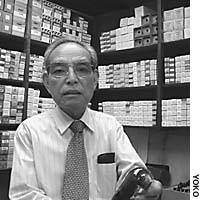Akihabara is not all about the state-of-the-art -- some technology from the analog era remains. Foremost among these relics is the vacuum tube, which dates back to around World War I. Thousands of music lovers believe that the sound produced by vacuum-tube amplifiers is superior to anything today's transistor amps can pump out.
Taiheiyo (Pacific Ocean), a 3-sq.-meter shop run by 73-year-old Tetsuichi Haryu, is one of many dealing in the elegant glass vials, from which the air has been evacuated to the highest possible degree and inside which electrons fly at almost the speed of light. For 50 years, Haryu has been catering mainly to do-it-yourself enthusiasts.
"Many major stores in Akihabara are an outgrowth of shops that started selling electron tubes or other electronic parts in the early 1950s," he says. "Most of the merchandise was sold wholesale to the shop owners by U.S. Occupation soldiers who had taken them from military storages for money to drink at bars and spend at cabarets."
Japanese makers stopped producing audio vacuum tubes around 1970; U.S. makers followed suit in the '80s; and then the Europeans. Now only China, Russia and Yugoslavia produce them. But Haryu deals in vintage tubes, such as Western Electric's 300B, Siemens' Ed and Telefunken's EL-156, and says he does not sell tubes from these countries because of their inferior quality.
Chuyu Morikawa, 68, the guru of tube-amplifier design and construction in Japan, runs Odio Senka (Audio Professor) in Akihabara. There he sells amp kits, ranging from 69,000 yen to 310,000 yen, and electronic parts made to U.S.-military specifications. A typical amp kit includes a chassis, tubes, a power-source transformer, a choke coil to stabilize the electric current, output transformers, capacitors and resistors.
For supporters of the tube amp, this vintage technology swims against the tide of mass production. While today's audio equipment comes in standardized "black boxes," tube amps give users the pleasure of tinkering, of soldering the parts together to please the ear.
"As DIY users change parts, the sound changes," Morikawa points out. "This way, listeners can create a system that produces a sound that is best-suited to their taste."
Ironically, tube amps make a perfect match for CDs, the musical representatives of digital technology, Morikawa says.
"CD sound has too strong an edge, and it does not give a three-dimensional depth. But if signals from CDs go through a tube amp, an exquisite sound comes from the speakers," he says.
"For those who have no experience of tube amps, I would suggest they first assemble one from an inexpensive kit, costing around 30,000 yen, whose quality is not bad. Then they can move to the next stage."
Although far outnumbered by transistorized amps, tube amps are the backbone of "pure hi-fi" for serious listeners of music, Morikawa insists. "Without tube amps, the world of pure hi-fi would become bleak and dreary indeed."


















With your current subscription plan you can comment on stories. However, before writing your first comment, please create a display name in the Profile section of your subscriber account page.